Human Impacts on Watersheds
Everyone on Earth lives in a watershed. Watersheds provide many benefits to humans and other living things. They give us water, provide places for recreation, like hiking and boating, and they provide habitat for plants and animals. Our oceans and major rivers also provide us with fish for food and a major means of transportation, so that we can ship goods all over the world. In turn, humans have huge impacts on the watershed they live in. In your assignment on the previous page, you may have learned about some ways that human activity is affecting your local watershed. You can also click each image to learn more about how human activity affects watersheds in general.
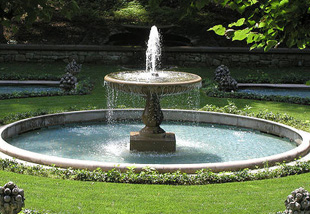 Withdrawal of water: We withdraw water from streams and from underground for many purposes. In some parts of the world, there is very little water, while other places have lots of water. As human populations grow, more and more people need water. In some parts of the world, we withdraw water from our watersheds faster than Earth’s water cycle can replenish the supply through precipitation. This can lead to water shortages and disrupt the natural flow of streams, which hurts wildlife.
Withdrawal of water: We withdraw water from streams and from underground for many purposes. In some parts of the world, there is very little water, while other places have lots of water. As human populations grow, more and more people need water. In some parts of the world, we withdraw water from our watersheds faster than Earth’s water cycle can replenish the supply through precipitation. This can lead to water shortages and disrupt the natural flow of streams, which hurts wildlife.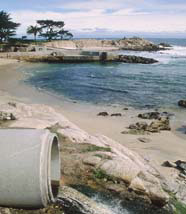 Pollution: Several human activities add pollution, or harmful substances, to the water in a watershed. We can pollute water directly by pouring chemicals into it or by littering. We also pollute water indirectly when we put harmful things on the ground. When runoff runs over the land, it picks those things up and carries them to local bodies of water.
Pollution: Several human activities add pollution, or harmful substances, to the water in a watershed. We can pollute water directly by pouring chemicals into it or by littering. We also pollute water indirectly when we put harmful things on the ground. When runoff runs over the land, it picks those things up and carries them to local bodies of water. 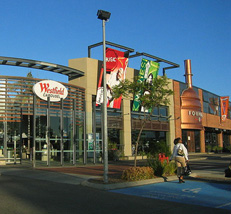 Construction and Development: The land around rivers and coasts is sometimes developed or built up with neighborhoods and shopping areas. This can alter the way that water flows within a watershed. We sometimes dam rivers or destroy the land around swamps and rivers to make water go in different directions so we can build in these locations. We sometimes even take water from one part of a watershed and pump it to another part to supply large cities with drinking water. This disrupts the natural flow of the watershed and can harm wildlife.
Construction and Development: The land around rivers and coasts is sometimes developed or built up with neighborhoods and shopping areas. This can alter the way that water flows within a watershed. We sometimes dam rivers or destroy the land around swamps and rivers to make water go in different directions so we can build in these locations. We sometimes even take water from one part of a watershed and pump it to another part to supply large cities with drinking water. This disrupts the natural flow of the watershed and can harm wildlife.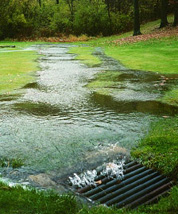 Erosion: Erosion decreases the ability of land to produce good crops. Soil that erodes away from the land often ends up getting carried by runoff to a stream. This muddies and pollutes the stream. Human activities like construction, farming, and driving off-road vehicles speed up erosion. The Dead Zone is an area in the Gulf of Mexico where agricultural chemicals have been carried to the Gulf by eroded soil and runoff. The chemicals originated far from the Gulf, as far away as Montana, but became part of the Mississippi River watershed. It eventually entered the Gulf when the river empties. The Dead Zone is so polluted with chemicals that aquatic life is severely limited.
Erosion: Erosion decreases the ability of land to produce good crops. Soil that erodes away from the land often ends up getting carried by runoff to a stream. This muddies and pollutes the stream. Human activities like construction, farming, and driving off-road vehicles speed up erosion. The Dead Zone is an area in the Gulf of Mexico where agricultural chemicals have been carried to the Gulf by eroded soil and runoff. The chemicals originated far from the Gulf, as far away as Montana, but became part of the Mississippi River watershed. It eventually entered the Gulf when the river empties. The Dead Zone is so polluted with chemicals that aquatic life is severely limited. 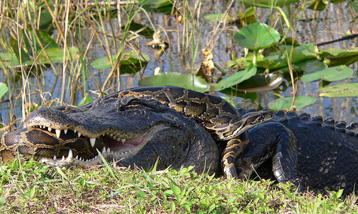 Introduction of plants and animals: Animals that do not normally live in a given area are called non-native. In Florida, for example, some people keep Burmese Pythons as pets. The pythons live naturally in Asia and not in Florida. Occasionally, people release the pythons into the wild in Florida and the pythons begin to reproduce. As they do, they cause harm to the Florida watersheds in which they live because they have no natural predators to keep them in check. With their numbers growing unchecked, the pythons eat other species in the area to the point of extinction and disrupt the entire ecosystem. Non-native plants and animals almost always have negative impacts on the environments in which they are released.
Introduction of plants and animals: Animals that do not normally live in a given area are called non-native. In Florida, for example, some people keep Burmese Pythons as pets. The pythons live naturally in Asia and not in Florida. Occasionally, people release the pythons into the wild in Florida and the pythons begin to reproduce. As they do, they cause harm to the Florida watersheds in which they live because they have no natural predators to keep them in check. With their numbers growing unchecked, the pythons eat other species in the area to the point of extinction and disrupt the entire ecosystem. Non-native plants and animals almost always have negative impacts on the environments in which they are released.
© KC Distance Learning. All rights reserved.





 Withdrawal of water: We withdraw water from streams and from underground for many purposes. In some parts of the world, there is very little water, while other places have lots of water. As human populations grow, more and more people need water. In some parts of the world, we withdraw water from our watersheds faster than Earth’s water cycle can replenish the supply through precipitation. This can lead to water shortages and disrupt the natural flow of streams, which hurts wildlife.
Withdrawal of water: We withdraw water from streams and from underground for many purposes. In some parts of the world, there is very little water, while other places have lots of water. As human populations grow, more and more people need water. In some parts of the world, we withdraw water from our watersheds faster than Earth’s water cycle can replenish the supply through precipitation. This can lead to water shortages and disrupt the natural flow of streams, which hurts wildlife. Pollution: Several human activities add pollution, or harmful substances, to the water in a watershed. We can pollute water directly by pouring chemicals into it or by littering. We also pollute water indirectly when we put harmful things on the ground. When runoff runs over the land, it picks those things up and carries them to local bodies of water.
Pollution: Several human activities add pollution, or harmful substances, to the water in a watershed. We can pollute water directly by pouring chemicals into it or by littering. We also pollute water indirectly when we put harmful things on the ground. When runoff runs over the land, it picks those things up and carries them to local bodies of water.  Construction and Development: The land around rivers and coasts is sometimes developed or built up with neighborhoods and shopping areas. This can alter the way that water flows within a watershed. We sometimes dam rivers or destroy the land around swamps and rivers to make water go in different directions so we can build in these locations. We sometimes even take water from one part of a watershed and pump it to another part to supply large cities with drinking water. This disrupts the natural flow of the watershed and can harm wildlife.
Construction and Development: The land around rivers and coasts is sometimes developed or built up with neighborhoods and shopping areas. This can alter the way that water flows within a watershed. We sometimes dam rivers or destroy the land around swamps and rivers to make water go in different directions so we can build in these locations. We sometimes even take water from one part of a watershed and pump it to another part to supply large cities with drinking water. This disrupts the natural flow of the watershed and can harm wildlife. Erosion: Erosion decreases the ability of land to produce good crops. Soil that erodes away from the land often ends up getting carried by runoff to a stream. This muddies and pollutes the stream. Human activities like construction, farming, and driving off-road vehicles speed up erosion. The Dead Zone is an area in the Gulf of Mexico where agricultural chemicals have been carried to the Gulf by eroded soil and runoff. The chemicals originated far from the Gulf, as far away as Montana, but became part of the Mississippi River watershed. It eventually entered the Gulf when the river empties. The Dead Zone is so polluted with chemicals that aquatic life is severely limited.
Erosion: Erosion decreases the ability of land to produce good crops. Soil that erodes away from the land often ends up getting carried by runoff to a stream. This muddies and pollutes the stream. Human activities like construction, farming, and driving off-road vehicles speed up erosion. The Dead Zone is an area in the Gulf of Mexico where agricultural chemicals have been carried to the Gulf by eroded soil and runoff. The chemicals originated far from the Gulf, as far away as Montana, but became part of the Mississippi River watershed. It eventually entered the Gulf when the river empties. The Dead Zone is so polluted with chemicals that aquatic life is severely limited.  Introduction of plants and animals: Animals that do not normally live in a given area are called non-native. In Florida, for example, some people keep Burmese Pythons as pets. The pythons live naturally in Asia and not in Florida. Occasionally, people release the pythons into the wild in Florida and the pythons begin to reproduce. As they do, they cause harm to the Florida watersheds in which they live because they have no natural predators to keep them in check. With their numbers growing unchecked, the pythons eat other species in the area to the point of extinction and disrupt the entire ecosystem. Non-native plants and animals almost always have negative impacts on the environments in which they are released.
Introduction of plants and animals: Animals that do not normally live in a given area are called non-native. In Florida, for example, some people keep Burmese Pythons as pets. The pythons live naturally in Asia and not in Florida. Occasionally, people release the pythons into the wild in Florida and the pythons begin to reproduce. As they do, they cause harm to the Florida watersheds in which they live because they have no natural predators to keep them in check. With their numbers growing unchecked, the pythons eat other species in the area to the point of extinction and disrupt the entire ecosystem. Non-native plants and animals almost always have negative impacts on the environments in which they are released.